Neo Geo AES Power Supply Adapter Guide:
If you've found yourself getting overwhelmed by all the various power supply names for the Neo Geo AES home console revisions like "NEO-POW3" or "PRO-POW-UL", or just want to pick up an AES that might not come with a power supply for your area, fear not. This guide will break things down into the simplest concepts to understand, as well as what to specifically look for inside your AES console to make certain of the power supply specs you need to use. Below is a classic example of two otherwise identical AES consoles, but with the exception of how power is handled on the motherboard:
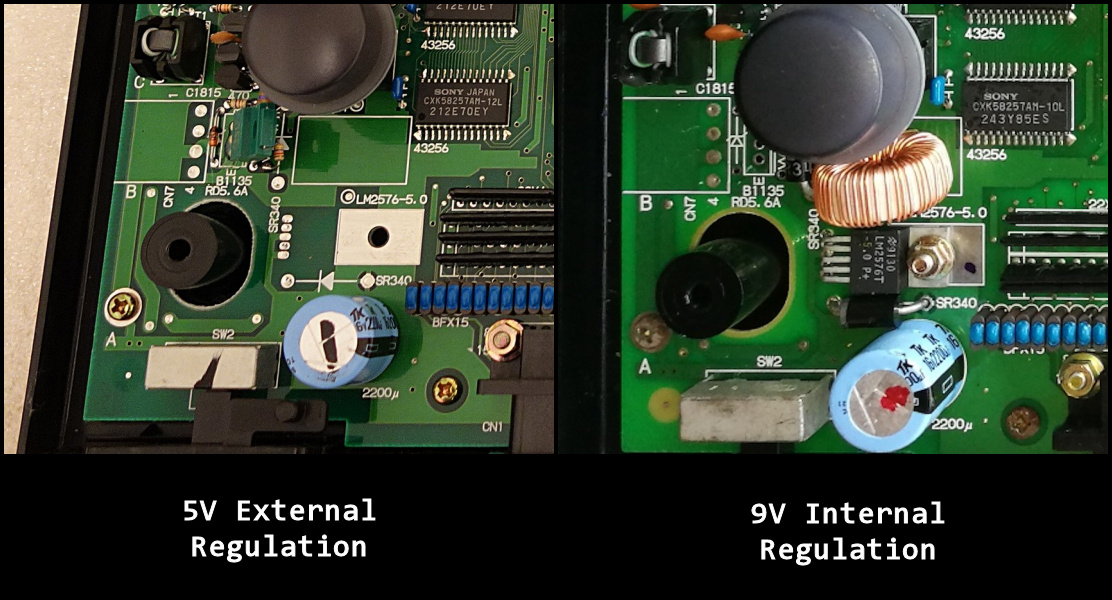
In my research, I found a lot of bad information that's been floating around on the Internet for years concerning this topic. Here's a dangerous remark concerning the NEO-AES3-3 on the actual Neo Geo Dev site:
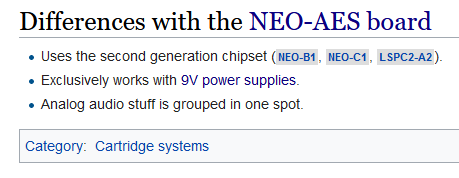
Claiming the AES3-3 exclusively works with 9V DC power supplies is flat-out WRONG! My own NEO-AES3-3 requires 5 volts DC externally regulated input, so following that advice would have likely damaged my console. We'll get to why that is in this guide.
Let's Get To It:
First and foremost, there are in reality only two flavors of power supply requirements to AES consoles. Some require 5 Volts DC with 3 Amps and a center-negative barrel plug (2.1mm center). Others require 9 Volts DC with 1 Amp and a center-negative barrel plug. Technically the latter will work with anything from 7.5 Volts up to 12 Volts, and that's why you may find some AES power adapters with an output rating of 10 or even 11 volts DC output. I'm going to stick with 9 Volts and recommend 2.5 to 3.5 Amps to ensure plenty of juice is available for stuff like mods that pull power. The 9V consoles regulate down to a maximum of 3 Amps inside the console, so there's no point in pushing beyond that unless there's no 9V 3A PSU available in the brand you prefer. That said, with power supplies on video game consoles, you don't have to worry about having too much Amperage. The console will only pull what it needs and nothing more. Voltage is much more volatile in this regard, so you want to make CERTAIN you don't overvolt an AES console.
Right, so now we need to figure out what power supply we should use. The Neo Geo AES console has had the following revisions over its lifetime:
NEO-AES
NEO-AES3-2 (incredibly rare prototype)
NEO-AES3-3
NEO-AES3-4
NEO-AES3-5
NEO-AES3-6
The Mistake Alpha Denshi Corporation Made:
So SNK didn't actually design the Neo Geo, but rather paid Alpha Denshi Corporation to upgrade ADC's old hardware from 1986 arcade architecture. The problem for the AES home console is ADC designed the power circuit to rely on external regulation (with VERY little wiggle room), requiring pretty much exactly 5 volts DC input (center pin negative and 3 Amps). Indeed if you lower the voltage, glitches and other issues start to creep up at 4.8 Volts. Likewise, if you go the other direction to 5.2 Volts, you start damaging the console. Accidentally plugging the wrong PSU like the "NEO-POW3" 11 Volts into one of these machines will fry them outright.
SNK realized this was a problem when they started getting reports of fried consoles. They quickly devised a factory patch mod board that replaces the existing power transistor circuit with an internalized power regulation circuit. This features an LM2576 voltage regulator (there are variants of this regulator, but they always start with those letters and numbers). Below is a photo of the patch board installed in an original NEO-AES console:
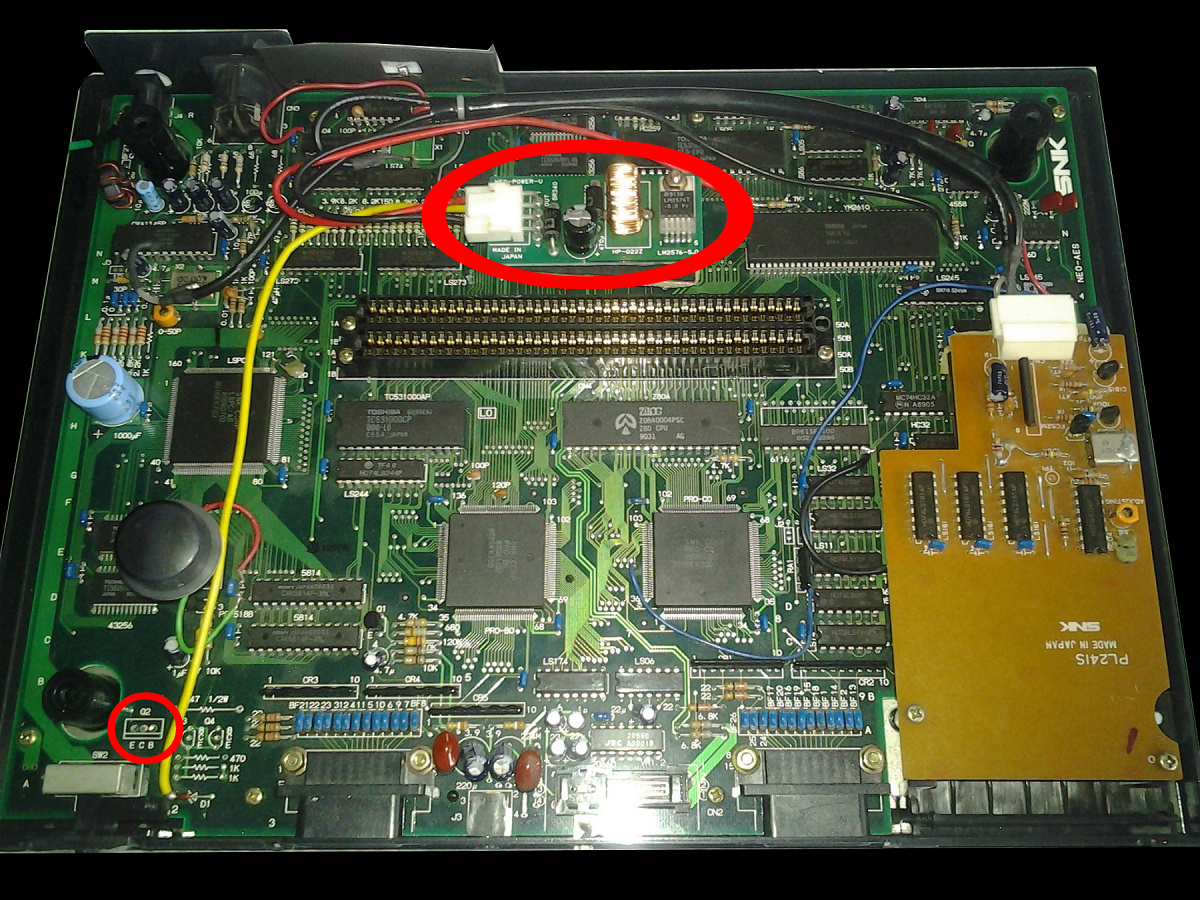
In the lower left-hand corner, I circled in red where the power transistor used to live before it got removed from the board. Upper center circled in red is the actual patch board with the LM2576 on it. This has converted this original AES console into one that requires a 9 Volt power supply instead of 5 Volts externally regulated power supply. Doing this internalized power regulation patch ensures a LOT more wiggle room on the voltage input without risking damage to the console.
Below is a closeup shot of the patch board so you can see very clearly the LM2576 as well as the copper wire coil next to it:
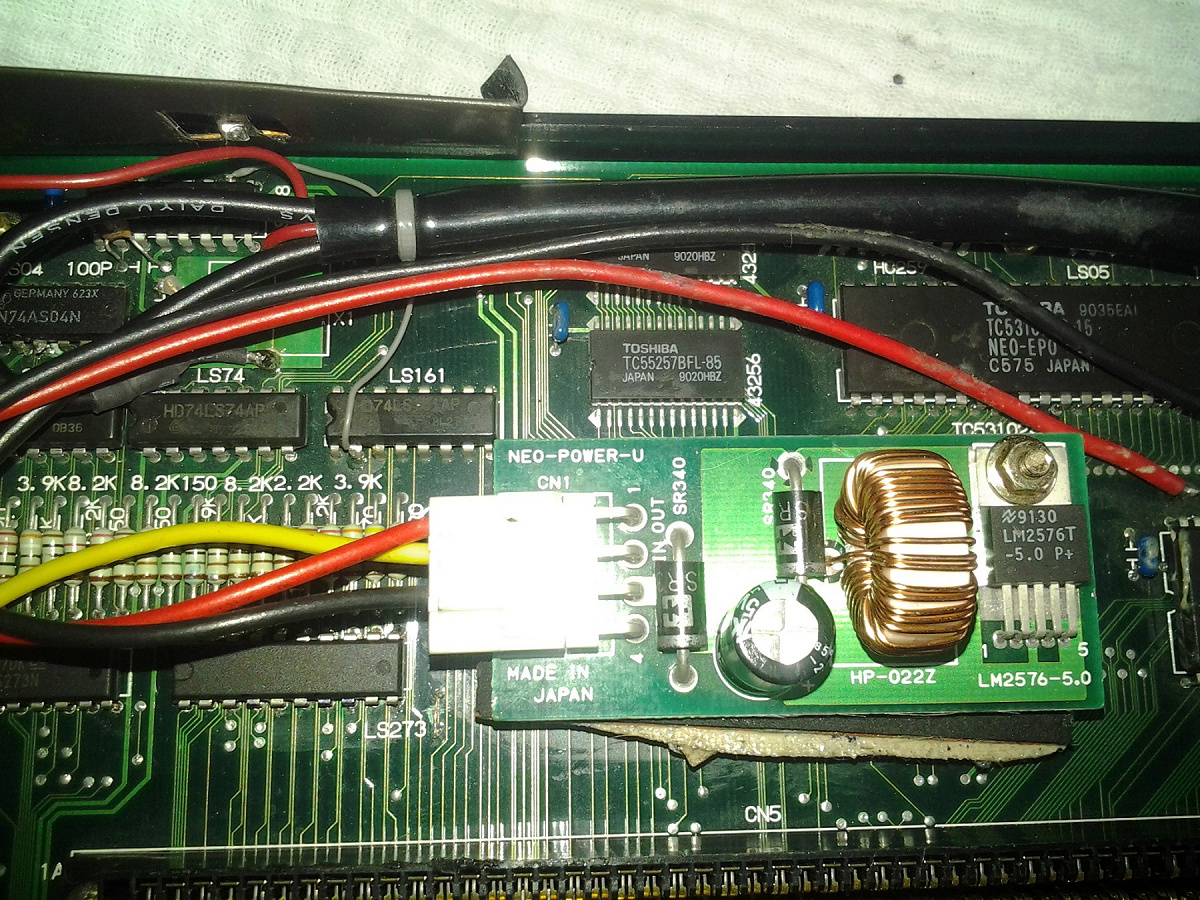
Some AES consoles would go on to have the LM2576 and that copper wire coil installed directly. However, you CANNOT go by revision since it was entirely random whether or not the patch board or the motherboard itself were configured for 9 Volts. Additionally, the AES is notorious for having a decent chunk of the consoles "board swapped" over the years. This is where someone takes the motherboard out of the console shell and puts it in a different shell. As such, you CANNOT trust the bottom label on the shell to be 100% accurate as to the power supply you need. The only way to know for sure is to open the console and look for the LM2576 and that distinctive copper wire coil. If you see both installed, you'll need a 9 Volt PSU.
Below is the original AES console without any modifcations done to it (and make note of the transistor in that lower left corner):
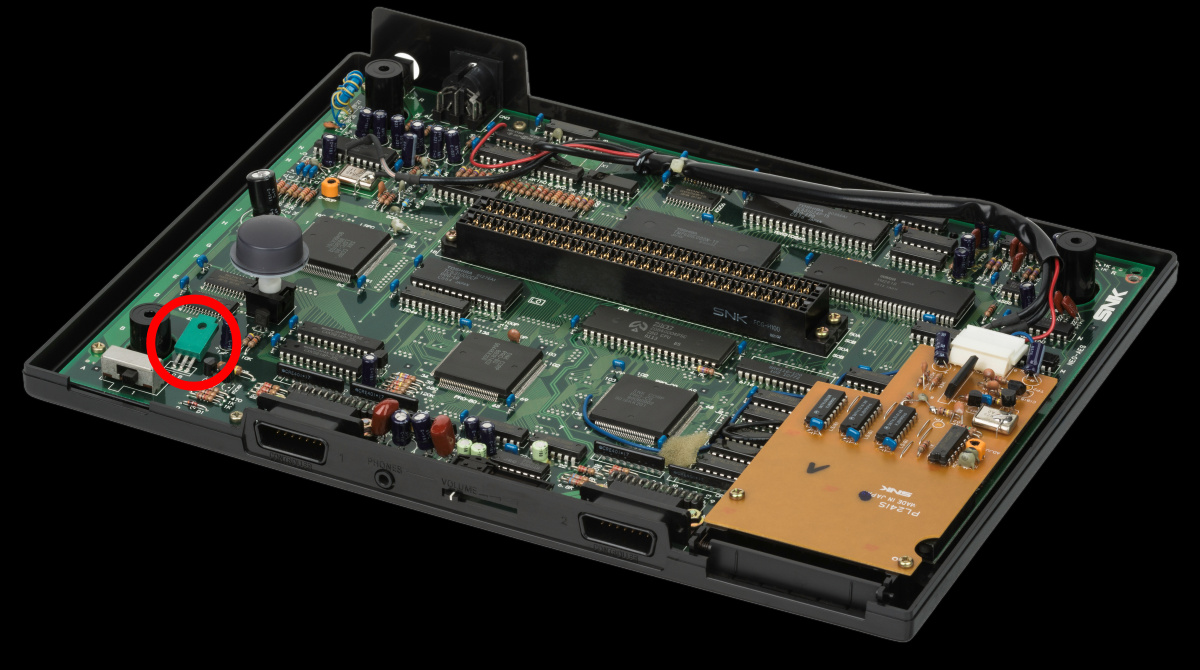
And here's a photo of my AES3-3 the first time I opened it, where you can see mine has a special daughterboard with a power transistor circuit mounted on top of the memory card port. Meanwhile the lower left-hand corner has all the unpopulated spaces meant for the LM2576 circuitry:
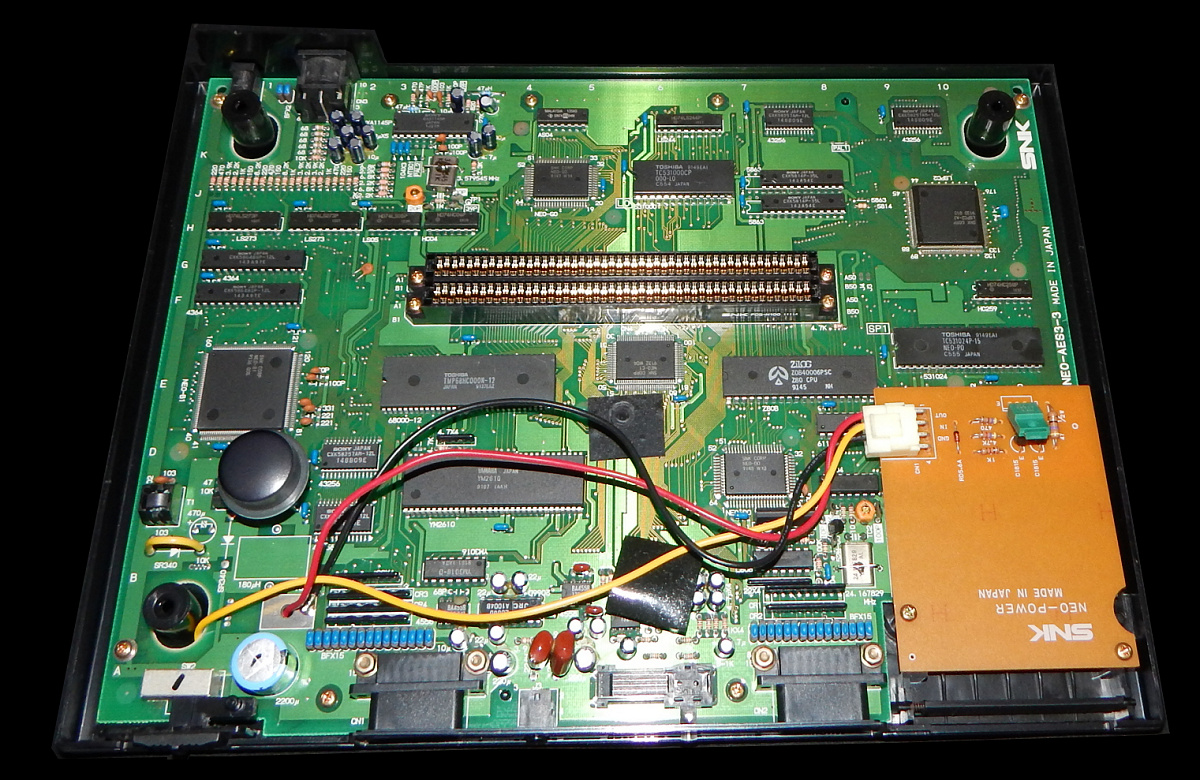
So What About ALL Those Official AES PSU Designations?
The various official AES PSU designations just give you an idea of what region it should be used in, as well as whether it's a 5V or 10V DC output. Note that confusingly, an AES console's bottom label may instruct to use a "PRO-POW3" PSU even though no such PSU exists. Those are labeled as "NEO-POW3". Here's a review of the designations and what specs they allude to:

Okay So What Should I Do If I Don't Have a PSU for My AES?
Since the ONLY thing you can trust is opening the console and examining the motherboard of the AES console, that's my recommendation to avoid any chance of frying the console with the wrong PSU. All you're going to do is look for that LM2576 regulator and copper wire coil. If you spot them either directly on the motherboard or patched in on a daughterboard, use a 9V 2.5A DC output center-negative PSU. If you don't spot them, use a 5V 4A DC output center-negative PSU. Refer to the image at the top of the web page showing the classic difference you need to watch out for.
As far as replacement power supply adapters go, I heap a lot of praise on Triad PSU's, so I personally recommend them for AES consoles. Here are links to each type for both North American and International regions:
Hope you found this guide useful! Cheers!
|
|